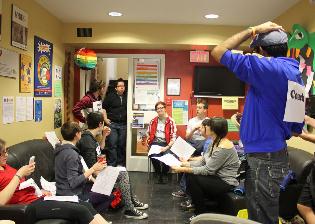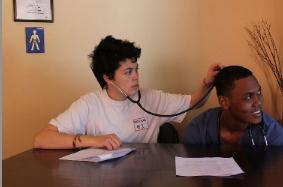
Toronto youth have spent weeks researching existing sexual health resources. Credit: Xtra file photo
Queer youth sex educator Kate Welsh’s own sex ed consisted of a lesson on anatomy when she was in Grade 5, an explanation of straight sex in Grade 7 and a discussion about sexually transmitted infections in Grade 9. “That’s it,” she says. “Yeah, not helpful.”
Shane Camastro started his education in a Catholic elementary school, where he explains that, like queer issues, sex didn’t exist as a topic of study. “Then I went to public school and thought that I was going to learn something finally, and the education we got was basically just STIs and pregnancy. That was it,” he says. “The funny part about that class was that it was not compulsory, so if you didn’t want to sit through a health class you got to go to the gym.”
While giving anti-homophobia and anti-transphobia workshops in his school, Camastro became familiar with Anna Penner and David Udayasekaran’s work on Teens Educating and Confronting Homophobia, a Planned Parenthood Toronto (PPT) program in which Welsh serves as a volunteer facilitator. The two youth activists were eager to become involved in a new PPT program seeking to compile sex education resources for queer and trans youth.
Eleven participants between the ages of 20 and 28 tackled the ambitious goal of “Queering Sex Ed” and trying to fill the gaps of what queer and trans youth missed in the province’s inconsistent and incomplete sexual education curriculums.
They spent weeks researching existing sexual health resources. “This included having a nurse come in and talk to us about sex ed, having sex educators come and talk to us, a bunch of anti-oppression training, and getting people from the community as guest lecturers to come talk to us about their experiences with sex ed and navigating different systems within that,” Welsh says. “We did a lot of our homework on sex ed before actually going into anything.”
The result of this first phase is a collection of resources for queer and trans youth that tackle six different broad topics as a starting point. “We have six resources that include a couple of different components,” Welsh says, “so for example, we have a resource focusing on consent and communication, something that is completely overlooked in sex education now, and we have a video component and PDF component for that.”
Accessibility, Camastro explains, is paramount to their tool kit, since everyone learns in different ways. “The videos tend to show a story line because, particularly with consent, it can be really fuzzy sometimes,” he says. “You can write it down and people can understand it that way, but some people, if they can’t actually see how somebody interacts or navigates a situation they won’t get it.”
Camastro believes that accessibility also includes making sure the resources don’t exclude anyone. “I’m pretty sure for the first six months, every time, I was like, ‘We need to talk about cissexism! Are we going to talk about cissexism?’ I’m pretty sure it was a bit of a broken record after a while,” he says. “That was the most important thing. Regardless of touching on heterosexism or any of those other things, if the language that we’re using itself already distances a whole group of people, then we’re not doing our job.”
Queering Sex Ed’s youth-friendly launch will comprise a resource fair, including a number of community sexual-health providers and organizations. The event will feature some of the youth videos (which both Welsh and Camastro appear in, the latter specifically as Lube Boy) and other performances.
“I was very adamant about a candy table,” says Camastro.
Queering Sex Ed Presents: Filling the Gaps, an evening of sex ed and revelry
Thurs, March 28, 6-10pm
Buddies in Bad Times Theatre
12 Alexander St


 Why you can trust Xtra
Why you can trust Xtra


